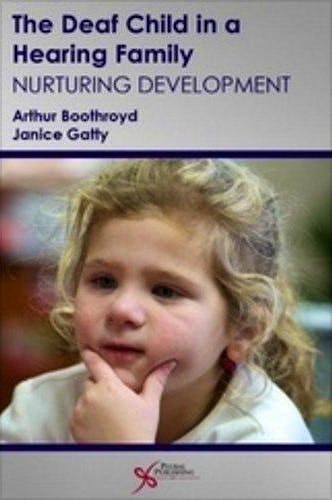

No hay productos en el carrito



The Deaf Child in a Hearing Family. Challenges and Potential Solutions
Boothroyd, A. — Gatty, J.
1ª Edición Noviembre 2011
Inglés
Tapa blanda
250 pags
1000 gr
null x null x null cm
ISBN 9781597563949
Editorial Plural Publishing Inc
LIBRO IMPRESO
-5%
49,75 €47,26 €IVA incluido
47,84 €45,44 €IVA no incluido
Recíbelo en un plazo de
2 - 3 semanas
Description
Hearing enables us to identify events from the sounds they make. Because sound travels a long way, we can identify events at a distance. Because sound travels rapidly we can identify events almost as soon as they occur. And because sound travels around corners we can identify events even when the objects involved cannot be seen.
One of the roles of hearing is that of watchdog. It works when we are not looking. It works when our eyes are closed. And it even works when we are asleep. During evolution, the survival advantages of such a sense are obvious. Many animals have further capitalized on hearing by generating sounds and using them for communication. In human beings, this development has merged with advanced cognitive abilities to produce spoken language. Language, regardless of its form, is key to many aspects of human development—cognitive, intellectual, literary, cultural, social, and emotional. Spoken language is the form of choice in all human societies. And hearing is crucial to the spontaneous acquisition of spoken language by the developing child. Conversely, hearing deficits place the development of spoken language at risk. And language deficits place most other aspects of development at risk. The importance of identifying childhood hearing loss as early as possible cannot be overemphasized. Nor can the importance of speedy and effective intervention designed to minimize both the hearing deficit and its developmental impact.
Boothroyd and Gatty’s new book is based on the assumption that the parents are hearing and that spoken-language competence has been established as a goal. Divided into six parts, the authors first summarize basic information on sound, hearing, hearing loss, language, speech, speech perception, and child development. For some readers, this will be a review of information already covered. For others it will serve as an introduction. Either way, it provides a background from which to draw implications about the management of hearing loss. The authors then move on to deal with sensory aspects of management, including information on hearing aids, cochlear implants, assistive listening devices, room acoustics, and lipreading. The assumption is that a first step in management is to optimize and capitalize on hearing when it is present and provide supplements when it is not. The third part deals with steps that can be taken to enrich the child’s learning environment.
The task of the child is learning; the task of those who interact with the child is to provide enriched environments and experiences that will facilitate and speed learning. Some of this enrichment may occur in clinical settings, some in day-care or preschool settings, and some, perhaps most, in the home. A section on social-emotional issues addresses the reactions of parents to the discovery that their child has a hearing loss, and the promotion of social-emotional development of the child, focusing on the need to avoid overemphasis on attainment at the expense of affiliation. The penultimate part deals with assessment—both formal and informal. The authors’ position is that the creation of an optimal learning environment depends on knowledge and awareness of the child’s capacities, abilities, and performance. This information, they assert, is essential for planning an effective, individualized program, for monitoring progress and adapting strategies, and for assessing outcome. The final part brings all the aforementioned topics together and discusses the needs for comprehensive intervention programs and intervention teams.
For audiologists in clinic, for school-based audiologists and speech-language pathologists, and for special educators, the wisdom and many years experience shared here make this book an essential and practical guide to the effective management of hearing loss in children.
Table of contents
· Background/Prerequisite Information: What the reader needs to know
· Sound and Hearing: How they work and what we use them for
· Hearing Loss: What can go wrong and how it is identified, diagnosed, and measured
· Role of Hearing in Development
· Nature and Primacy of Language
· Consequences of Hearing Loss: How hearing loss and language deficits affect development
· Factors Affecting the Severity of the Consequences
· Intervention as Enrichment: Sensory, auditory, perceptual, cognitive, linguistic, social, and emotional
· Time-on-Task: Spoken language immersion
· Family: Primacy of the parental role and the family as the child’s culture
· The Complexity of Development and the Dangers of Simple Approaches to Intervention
· Sensory Management: Giving the child the best possible access to sound and speech
· Goals
· Hearing aids
· Cochlear Implants
· FM microphones
· The Acoustic Environment
· Lipreading
· Hearing: Listening and hearing skills
· Goals
· Lipreading: When it does or does not make sense to focus on hearing alone
· Techniques
· Perceptual Development: Constructing a sensory system through movement and experience
· How do infants learn?
· Goals in the First Two Years of Life
· Activities that Enhance Perceptual Development
· Observable Behaviors Suggesting Perceptual Development is Proceeding
· Social Development: Establishing a context for learning spoken language
· Attachment and Trust
· Reciprocity and Turn Taking
· “Knowing” the child
· Cognition: Developing a world model
· Symbolic Play
· Preschool Skills and Milestones
· Activities that Enhance Construction of a World Model
· Non-verbal Aspects of Spoken Language
· Language: Spoken language knowledge and competence
· Methodological Choices
· Goals
· Phonology
· Vocabulary
· Grammar
· Pragmatics
· Receptive skills
· Speech
· Techniques
· Family: Working with parents and other caregivers
· Counseling
· Educating
· Coaching
· Empowering
· Techniques
· Assessment
· Evidence-based Practice: General and individual
· Needs Assessment
· Outcome Evaluation
· Laws and Resources
© 2025 Axón Librería S.L.
2.149.0